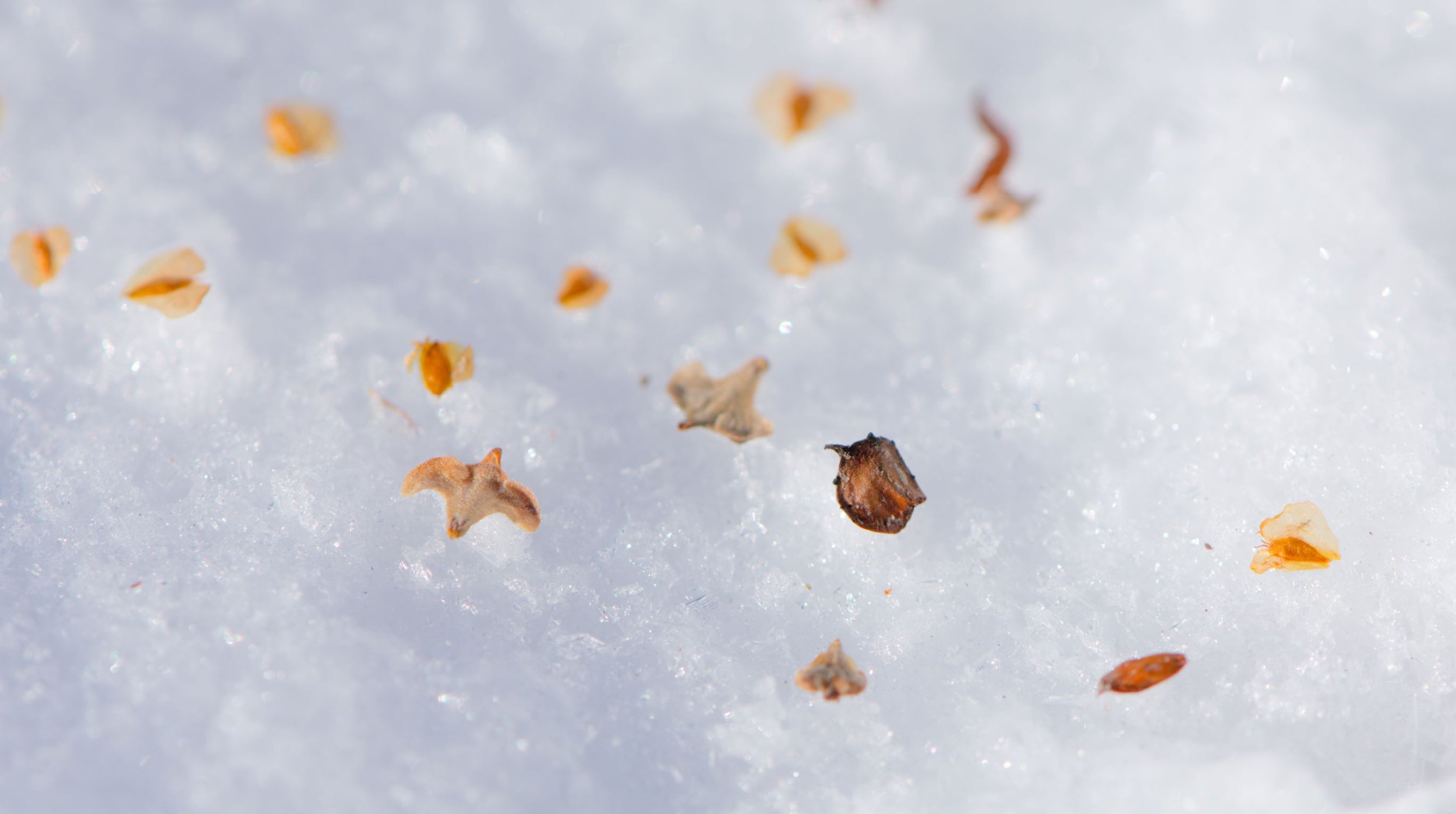Seeds on Snow
Originally published here in February 2022, Seeds on Snow was re-printed by permission in the January 2023 issue of Maine Woodlands, the monthly newsletter of the Maine Woodland Owners
By Jennifer Brockway, text & photos
One of the coolest features of winter is the ever-changing story recorded in the snow. The familiar tracks of a snowshoe hare. A lost blue jay feather. The dramatic imprint of wings where an owl? a hawk? plucked prey from the snow. The scatter of soil and acorn pieces outside a raided cache. The sinuous track of mice or voles moving about below the surface.
Or one of my favorite finds, the ‘little birds’ scattered across the snow beneath a birch tree. Have you seen them?
Bird-shaped scales and winged seeds on the snow are a tell-tale sign of a birch tree nearby. The larger, dark-brown seed right of center is that of an alder.
Reminiscent of tiny birds, iris blossoms or fleur-de-lis, they are a common sight in early to mid winter.
What are they? These fancifully shaped scales are the remains of birch catkins as they break apart, shedding scales and tinier seeds onto the snow beneath. As many as 1,000 winged seeds may be released from a single catkin.
Birch catkins freshly fallen from a tree, together with the scales (little birds) and winged seeds.
Once released, the seeds may travel far, jumping across the snowy surface on delicate wings, blown by the winds or caught up in drifting snow.
There are several common species of birch, Betula, in our region, including paper birch (Betula papyrifera), gray birch (Betula populifolia) and, my favorite, yellow birch (Betula alleghaniensis), and all produce slightly different forms of this bird-like scale. On your next winter walk, find a birch tree and you will likely find its neatly packaged seeds spread out across the snow. If the snow has a nice crust, the seeds could extend hundreds of feet from their source tree. In fresh snow or no snow at all, transport will be brief before the little seeds are trapped in the fresh powder, dead grasses or other debris.
Birch seeds and scales scattered across a crusty snow, along with several larger, dark brown alder seeds.
Why drop seeds in winter? As Aristotle said, “nature does nothing uselessly.”
As pioneer species, birches (and alders) are one of the first trees to colonize bare sites. Their seeds are tiny and without the energy to fuel their survival - unlike an oak and its nutrition-packed acorn, for example. To be successful, birch seeds must germinate in the sun of an open site, not the shade found beneath their source tree. Birches use the wind to more widely distribute seeds, a process known as anemochory.
To increase the chances seed will germinate in a favorable location, birches drop their seeds over an extended period from autumn into winter - exposing seeds to a wide range of conditions. With a snow-covered landscape allowing seeds to travel greater distances, it is no surprise to learn that studies show birch seeds dropped in winter have the highest germination rates.
Birch seeds and scales trapped in a depression left by a ski pole. Tucked out of the wind, these seeds may travel no further.
The vast quantity of seed produced by birch trees provides winter bounty for a variety of birds and small mammals. Juncos, goldfinches, chickadees, sparrows, titmice, nuthatches, redpolls, can be found feasting in and under birches in winter. Ruffed grouse will feed on the catkins and seeds, as well as the buds. Red squirrels, too. Birches offer so many benefits, in fact, that naturalist Doug Tallamy ranks them in the Top 5 Best Woody Plants for Wildlife in his book Bringing Nature Home.
Seeds on snow. Just another reminder of the magic to be found in the woods.
The remains of a birch catkin, and its winged seeds.
Birch and alder seeds blown far from their source across a field of crusty snow.
Jennifer Brockway is Outreach Coordinator for Somerset County SWCD and a woodland owner and enthusiast based in Waldo County.






